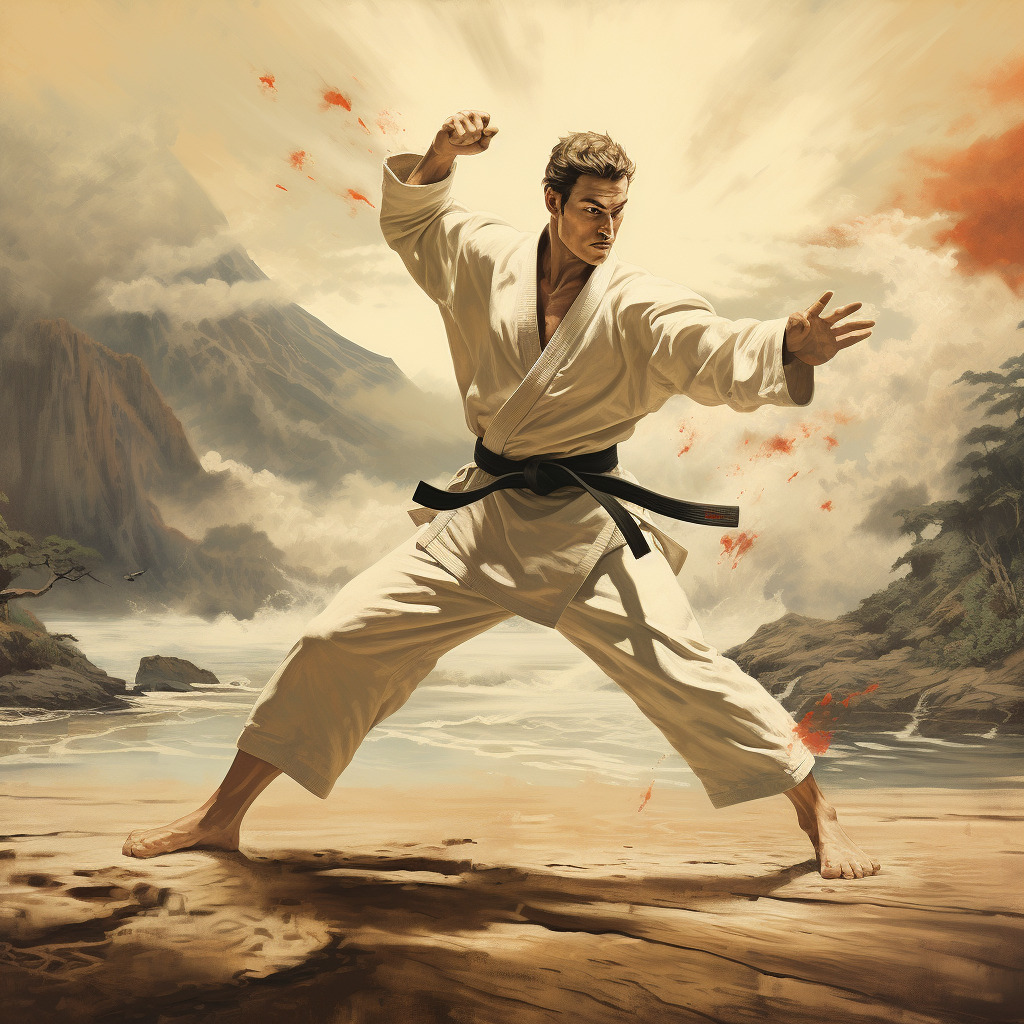Das Besondere an der Entwicklung des Karate ist in erster Linie die Zeit, die es bereits überdauerte, bevor es sich zu einem modernen Kampfsport entwickelte. Die Karate Entstehung lässt sich bis ins 19. Jahrhundert eindeutig zurückverfolgen und findet als öffentlich akzeptierte Kampfsportart in Okinawa um das Jahr 1875 ihren Ursprung. Der Weg bis dahin jedoch war sehr steinig. Unter Historikern wird gestritten, ob der Ursprung des Karate in einer Abwandlung des im 6. Jahrhundert geschaffenen Shaolin Kung Fu liegt, dies konnte bisher jedoch weder eindeutig bewiesen noch widerlegt werden.

Karate hat chinesische Wurzeln
Tatsache ist, dass Karate tatsächlich chinesische Wurzeln hat. Okinawa, das damals noch nicht zu Japan gehörte, unterhielt bereits im 14. Jahrhundert ausgeprägte Handelsbeziehungen zu Japan, Korea und China. In dem Austausch von Waren schwang auch ein Teil der chinesischen Kampfkunst nach Okinawa hinüber und vermischte sich mit den einheimischen Kampfkünsten zum Okinawa-Te (Übersetzung: die Hand aus Okinawa).
Durch ein Waffenverbot auf Okinawa sowie allen Inseln rundherum im Jahre 1422 erlangte die unbewaffnete Kampfkunst eine immer größere Bedeutung, doch erst nach der Verschärfung dieses Verbotes in 1609 bis zum Extremen schlossen sich die Meister der Kampfkunst zusammen, um insgeheim Schüler zu unterrichten, damit diese sich gegen die willkürlichen Gewaltakte der Samurai zur Wehr setzen konnten. Etwa zur gleichen Zeit entwickelte sich auch das Kobudō, welches einfache Bauerngegenstände zu Waffen umfunktioniert. Diese Kampfkünste wurden zwar von den Shogunen ebenfalls verboten, aber unter Geheimhaltung weiter unterrichtet.
Entstehung des modernen Karates
Bis Okinawa 1875 zu einer japanischen Präfektur erklärt wurde, blieben die Lehren des Karate den Wenigen vorbehalten, deren Familien davon Kenntnis hatten. Karate gelangte erst nach 1875 langsam wieder an die Öffentlichkeit und wurde ab 1902 auf Okinawa als Schulsport praktiziert. Die Karate Entstehung hatte an diesem Punkt die Zeiten der Nutzung als reine Selbstverteidigung überdauert und die Kampfkunst wurde nun auch zur Leibesertüchtigung genutzt.
Man unterteilt Karate heute in vier große Stilrichtungen, die sich überwiegend aus den okinawaischen Stilen Shōrei-Ryū und Shōrin-Ryū herauskristallisierten.
Karate heute
Ursprünglich als Verteidigungsmethodik gegen die willkürliche Gewaltanwendung ungerechter Herrscher entworfen, stellt Karate heute eine der weltweit am weitesten verbreiteten Kampfsportarten dar. Die 1993 gegründete World Karate Federation (WKF) ist der höchste Verband und zählt in 188 Ländern über 10 Millionen Mitglieder.
Bei den olympischen Spielen 2020 in Tokyo wird Karate erstmals als Disziplin vorgestellt, die World Games jedoch haben es seit ihrer erstmaligen Veranstaltung 1981 im Programm. Karate hat also nicht nur einen Weg herunter von der japanischen Inselkette gefunden, sondern wird heute weltweit praktiziert und gilt als eine hochangesehene Kampfsportart.
Karate Stilrichtungen
Die vielschichtige Entwicklung der Karate Stile kann zum Teil darauf zurückgeführt werden, dass die Ausübung der Kampfkunst über Jahrhunderte verboten war und sich im Geheimen und bei jeder Familie anders entwickelte. Teilweise werden die ursprünglichen Stile heute noch betrieben, stellen aber eher die Ausnahme dar.
| Shōtōkan | Der Karate Stil Shōtōkan wurde im 20. Jahrhundert von Funakoshi Gichin begründet und ist heute die am weitesten verbreitete Stilrichtung. Charakteristisch für Shōtōkan-Karate ist der sehr tiefe Stand des Karateka und die Tatsache, dass alle Techniken gleichermaßen für Angriff und Verteidigung genutzt werden können. |
| Gōjū-Ryū | Der Stil Gōjū-Ryū ist ebenfalls sehr verbreitet und bekam seinen Namen von Chōjun Miyagi Anfang des 20. Jahrhunderts, reicht aber in seinen Wurzeln deutlich weiter zurück. Er enthält viele Bewegungen des chinesischen Boxens, wie es bereits im 17. Jahrhundert ausgeübt wurde, lehrt aber auch alle anderen karatetypischen Schlag und Tritttechniken sowie Würfe und Hebel. |
| Shitō-Ryū | Shitō-Ryū wurde 1934 von Mabuni Kenwa gegründet, welcher gleichermaßen von Higashionna Kanryō und Itosu Yasutsune unterrichtet wurde. Dieser Stil enthält diverse chinesische Einflüsse und sogar Kata, die in den anderen Karate Stilen nicht vorkommen. |
| Wadō-Ryū | Wadō-Ryū wurde von Hironori Ōtsuka gegründet und ist seit 1939 als Karate-Stil registriert. Die Besonderheiten an diesem Stil sind, dass mit jedem Angriff eine Änderung der Körperstellung einhergeht und dass die Blocktechniken keine Angriffe abwehren, sondern umlenken, um die Kraft für den Konter zu nutzen. |
- Boxsack Basics: Findet den perfekten Boxsack für euer Heimtraining - 23. November 2023
- Mobbing am Arbeitsplatz: Tipps & Hilfestellungen für Betroffene - 15. November 2023
- Wohnung & Haus effektiv vor Einbruch schützen: 10 Tipps & FAQ - 3. November 2023
